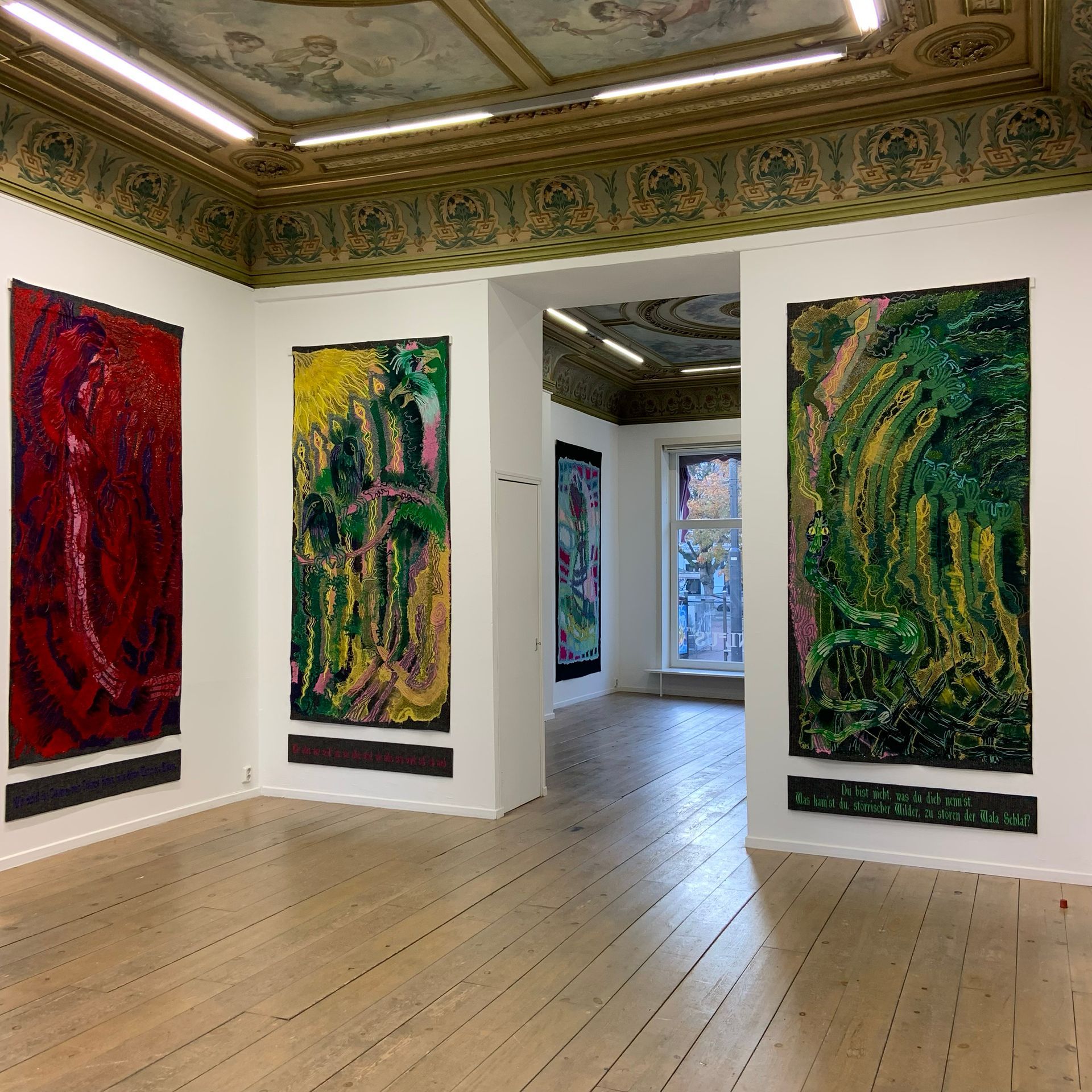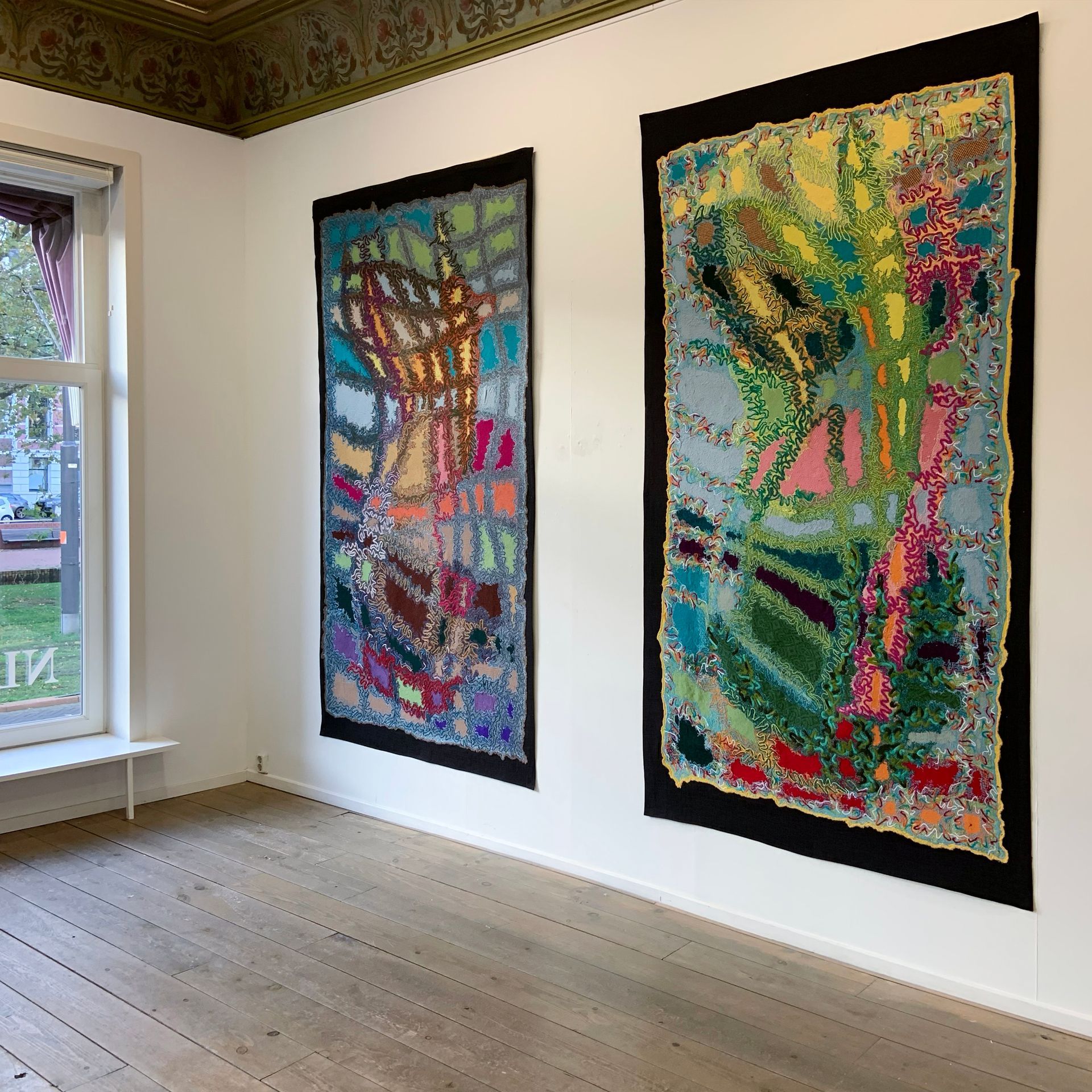Tapestries
7 tapestries
Textile Allegories as Human Connections to the Environment
Ancient wisdom and modern ecological philosophy converge in the textile journey ‘Das Lied von der Erde’ by Dutch designer and textile artist Peter George d’Angelino Tap. Inspired by Attar’s epic ‘Conference of the Birds,’ Albrecht’s Earth Emotions, and the enigmatic verses of Erda in Wagner’s Ring, d’Angelino Tap leads us on an immersive odyssey through seven needle-felted metaphorical valleys, exploring the philosophical and emotional dimensions of the relationship between humanity and the environment.
Attar’s 12th-century epic Sufi poem ‘The Conference of the Birds’ follows the avian quest across seven valleys in search of their legendary king, only to reveal that their monarch is a reflection of their own essence. These valleys, in turn, symbolise the vast spectrum of earthly emotions and the interplay between humanity and the environment. Environmental philosopher Glenn Albrecht’s ground-breaking work on Earth Emotions significantly informs d’Angelino Tap’s tapestries. Albrecht delves deep into the emotional and psychological responses elicited by the harsh realities of environmental degradation, climate change,
and the loss of biodiversity. His call for a deeper emotional connection with the earth and a shift towards an ecocentric worldview resonates profoundly in today’s global environment crisis.In d’Angelino Tap’s tapestries, Albrecht’s Earth Emotion definitions are juxtaposed with the original valleys, offering a contemporary reflection of our relationship with nature. Additionally, the embroidered cryptic lines by Earth’s mother, Erda, from Richard Wagner’s ‘Der Ring des Nibelungen,’ create an oracle-like quality that emphasizes the urgency of the environmental issues we face. Wagner’s Ring cycle, rich in symbolism and allegory, underscores the destructive forces of human desire and the corruption of the natural world by our actions. It mirrors the ongoing struggle between the untamed forces of nature and humanity’s attempts to control and dominate these forces.
Through d’Angelino Tap’s work, viewers are invited to contemplate these complex narratives, forging connections between ancient allegories and the pressing environmental concerns of our modern age. This series of tapestries is a powerful reminder of the need for deeper reflection, connection with nature, and collective action to address the challenges of our time.
“On our life journey, like Attar’s ‘The Conference of the Birds,’ we navigate the seven valleys of earthly emotions. To protect our feathers, we must hold dear the natural world and existence itself – the very fabric we are woven into."
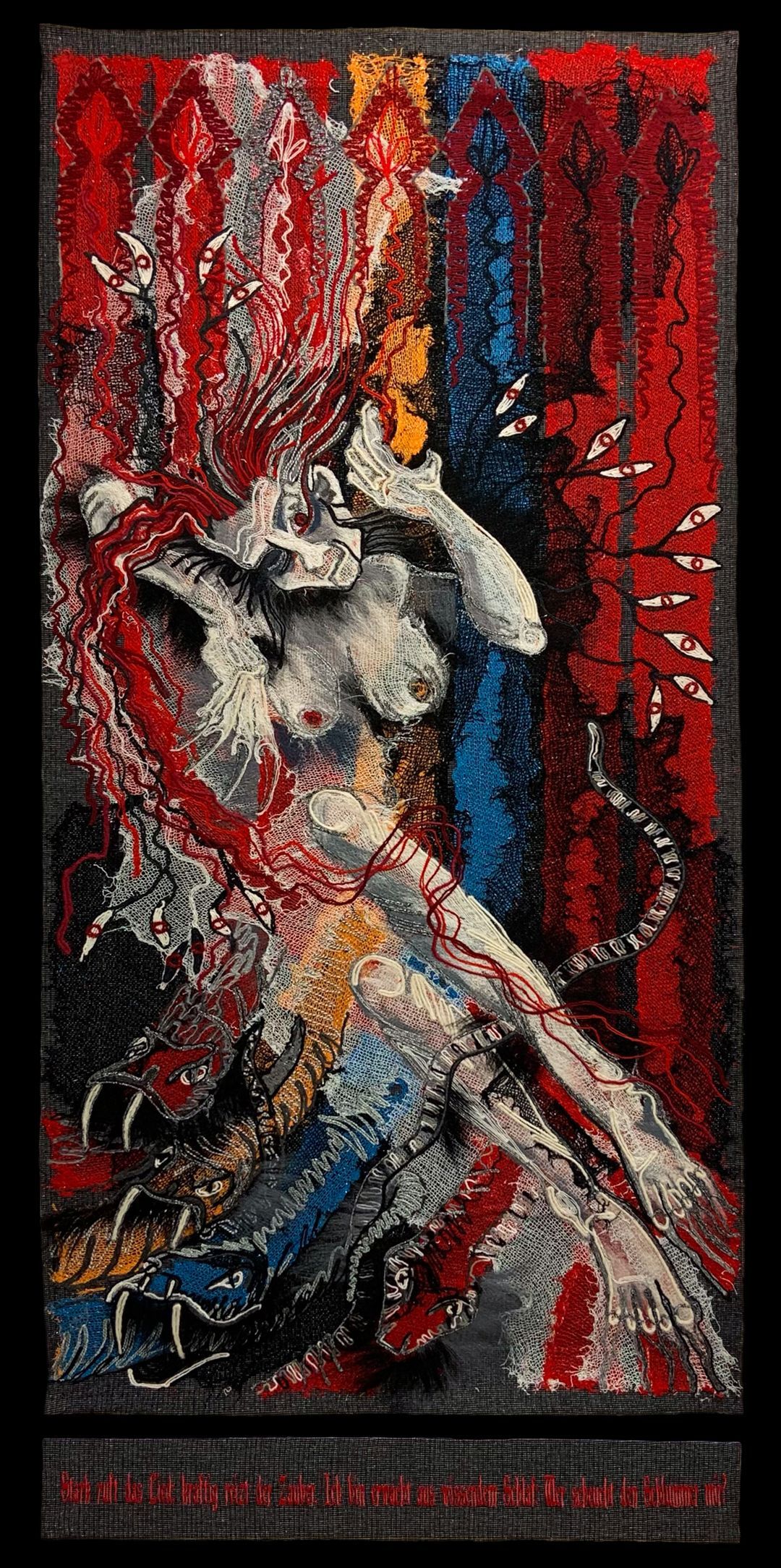
DAS LIED VON DER ERDE
Solastalgia
The first tapestry in the series portrays Erda in slumber, one eye peacefully closed, the other watchful and alert..The tips of her hair extend like vigilant antennae, attuned to the eternal beyond. Stirred from her tranquil sleep, Mother Earth begins to awaken, roused by the emotional upheaval unleashed by human hands. The composition cradles Erda as though she lies reclining in the Valley of the Quest.
In a parallel to Wagner’s opera, Erda’s awakening provokes disruptions in the weft of the ongoing warp of life:
“Powerful the song entices, overwhelmingly surges the spell,” Erda sings, “I am awakened from a vigilant sleep. Who dares disturb my slumber?”
Solastalgia, 2023
Needle-felted tapestry
250 x 120 cm
Knitted wool, yarn, roving on wool mix
Stark ruft das Lied; kraftig reizt der Zauber. Ich bin erwacht aus wissendem Schlaf: wer scheucht den Schlummer mir?
—Erda, Der Ring des Nibelungen, Richard Wagner

DAS LIED VON DER ERDE
Soliphilia
The heart, an enduring symbol of love and life, is positioned at the core of the tapestry. It connects with a distressed, circling falcon in search of its absent nest. Its talons are firmly embedded in the bleeding heart. The Western iconography is deliberate: the ‘Holy Heart’, a Christian devotional depiction, carries profound symbolism, representing the eternal love of Jesus.
The vibrant red yarn and roving, the wandering falcon under a crimson sun; all seem on a quest for love to mitigate the dark, purple backdrop.
“My sleep is dreaming, my dreaming is sensing, my senses reign all knowledge.”
—Erda
Soliphilia, 2023
Needle-felted tapestry
250 x 120 cm
Knitted wool, yarn, roving on wool mix
Mein Schlaf ist Traumen, mein Traumen Sinnen, mein Sinnen Walten des Wissens.
—Erda, Der Ring des Nibelungen, Richard Wagner

DAS LIED VON DER ERDE
Symbioment
The third tapestry unravels the enigma as Erda conjures the essence of her being; "How everything was I perceive: how everything evolves, how everything will be: I also behold, an eternal world's primeval forest."
In the upper left corner, the sun completes the celestial path initiated in the preceding piece. Two ravens, Heugin and Meugin, bask in the sun, a reference to Wotan’s companions in Norse mythology. Etymologically, Heugin is linked to memory, that what is in the brain, while Meugin symbolises everything one intellectually has, that which one metaphorically owns. They are perched on the branches of Ygg Drasil, the Axis Mundi, emerging from the background. The tree bridges heaven and earth and protects the world and humanity from all evil. Vigilant eyes of the gods are reflected by the double headed eagle. The cosmic and mythic are woven together in yellow and green yarn.
Symbioment, 2023
Needle-felted tapestry
250 x 120 cm
Knitted wool, yarn, roving on wool mix
Wie alles war weiss ich: wie alles wird, wie alles sein wird: seh’ich auch der ew’gen Welt Urwald.
—Erda, Der Ring des Nibelungen, Richard Wagner

DAS LIED VON DER ERDE
Mermerosity
The fourth tapestry depicts the inverse of the protective Yggdrasil, the tree shielding us from malevolence. Its trunk and branches are morphed into six weeping women, Pleureuses, emerging from the roots.
Continuing the thematic elements in the previous tapestries, the apex of the foundational composition - rendered here in verdant green - morphs into arabesques that take shape as the faces and hands of the mourning Pleureuses. Mourning is a deep and complex pain, shaped by both biology and culture. Today, we find ourselves in a collective state of global mourning. Top left, a squirrel, mythic messenger between gods and humans, delivers unsettling news from Mother Earth. Amidst sweeping transformation, we appear adrift, navigating a Valley of Detachment, a space enigmatically echoed in the silent wisdom of Erda: “Thou art not what thou call’st thyself. Why hast thou, stubborn savage, come to disturb the sleep of Wala?”
Mermerosity, 2023
Needle-felted tapestry
250 x 120 cm
Knitted wool, yarn, roving on wool mix
Du bist nicht, was du dich nenn’st. Was kam'st du, störrischer Wilder, zu storen der Wala Schlaf?
—Erda, Der Ring des Nibelungen, Richard Wagner
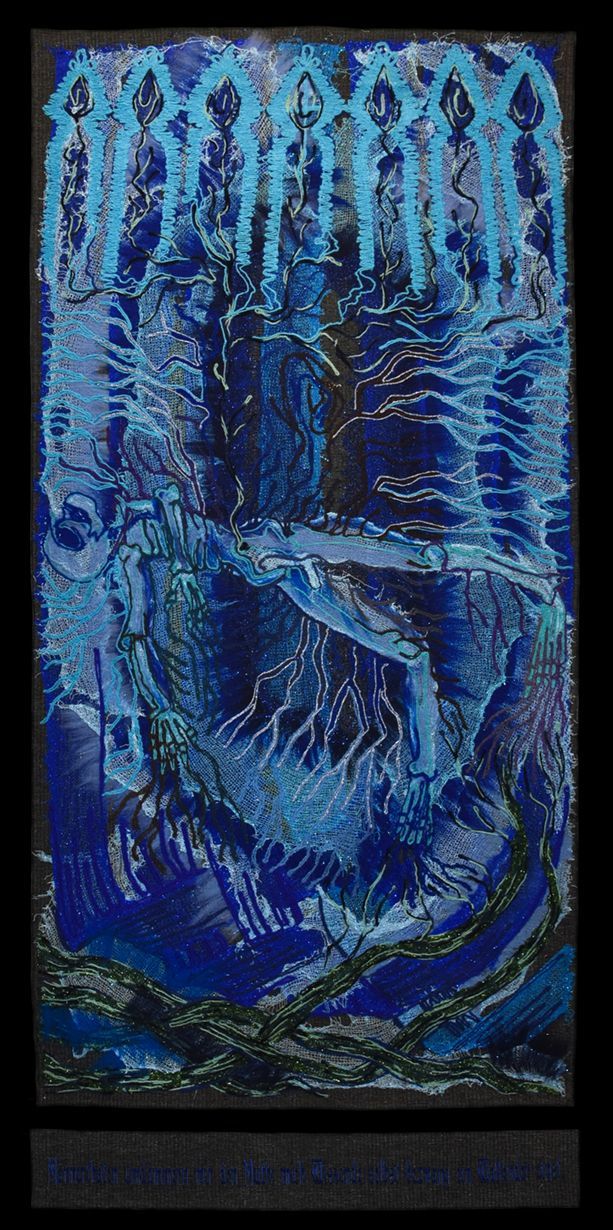
DAS LIED VON DER ERDE
Sumbiosic
Set against a knitted blue backdrop, the tapestry unravels its narrative in shades of blue yarn and roving. The story of human transgression begins with the expulsion from paradise, a fall that marks the genesis of our disconnection. From the grave of the first man, Adam, a tree emerges; a symbol that, according to apocryphal tradition, would later provide the wood for the crucifixion of the Son of God. The sign of the cross is subtly embedded within the architectural intricacies of the arabesques. Here, unity prevails: nature and life remain intricately intertwined, much like the mycelium threads that bind this composition in an organic, dramatic form.
In a state of fevered clarity, Erda delivers her chilling verdict: “Man's deeds have damned my courage; My cognizant self was once subdued by a wayward wanderer.”
Sumbiosic, 2023
Needle-felted tapestry
250 x 120 cm
Knitted wool, yarn, roving on wool mix
Mannerthaten um dämmern mir den Muth; mich Wissende selbst bezwang ein Waltender einst.
—Erda, Der Ring des Nibelungen, Richard Wagner
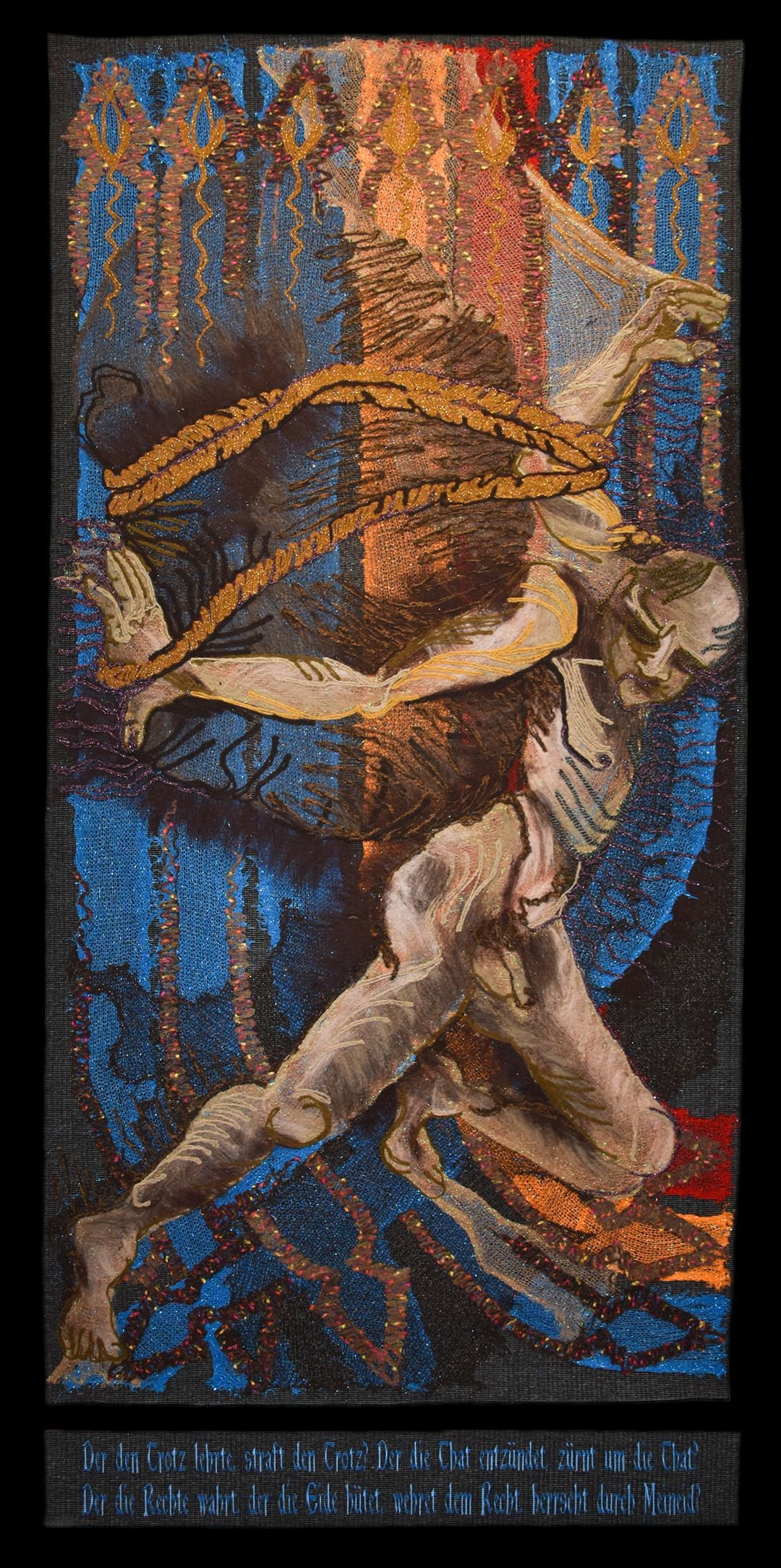
DAS LIED VON DER ERDE
Topoaversion
Against a cyan knitted backdrop, the once regal Sisyphus emerges, burdened by an imaginary rock, woven from brown yarn and roving. Like the mythical figure himself, we too are trapped in a cycle of self-inflicted punishment, driven by hubris and the relentless belief that we can conquer all obstacles. Day after day, we drag the weight of our own making towards a summit, only to find that each new dawn demands we begin again..
We exist in a state of bewilderment, where certainty has dissolved into confusion. What was once up is now down; the arabesques that once reached for the heavens now spiral towards the abyss. Amidst this unraveling, Erda, the oracle, murmurs her lament, her words scattered like seeds on the wind: “Who has been thought conceit, punishes conceit? He who kindles achievement, is aggravated because of achievement? He who preserves the rights, who protects oaths; defies justice, reigns by perjury?”
Topoaversion, 2023
Needle-felted tapestry
250 x 120 cm
Knitted wool, yarn, roving on wool mix
Der den Trotz lehre, straft den Trotz? Der die That entzündet, zürnt um die That? Der die Rechte wahrt, der die Eide hütet, wehret dem Recht, herrscht durch Meineid?
—Erda, Der Ring des Nibelungen, Richard Wagner
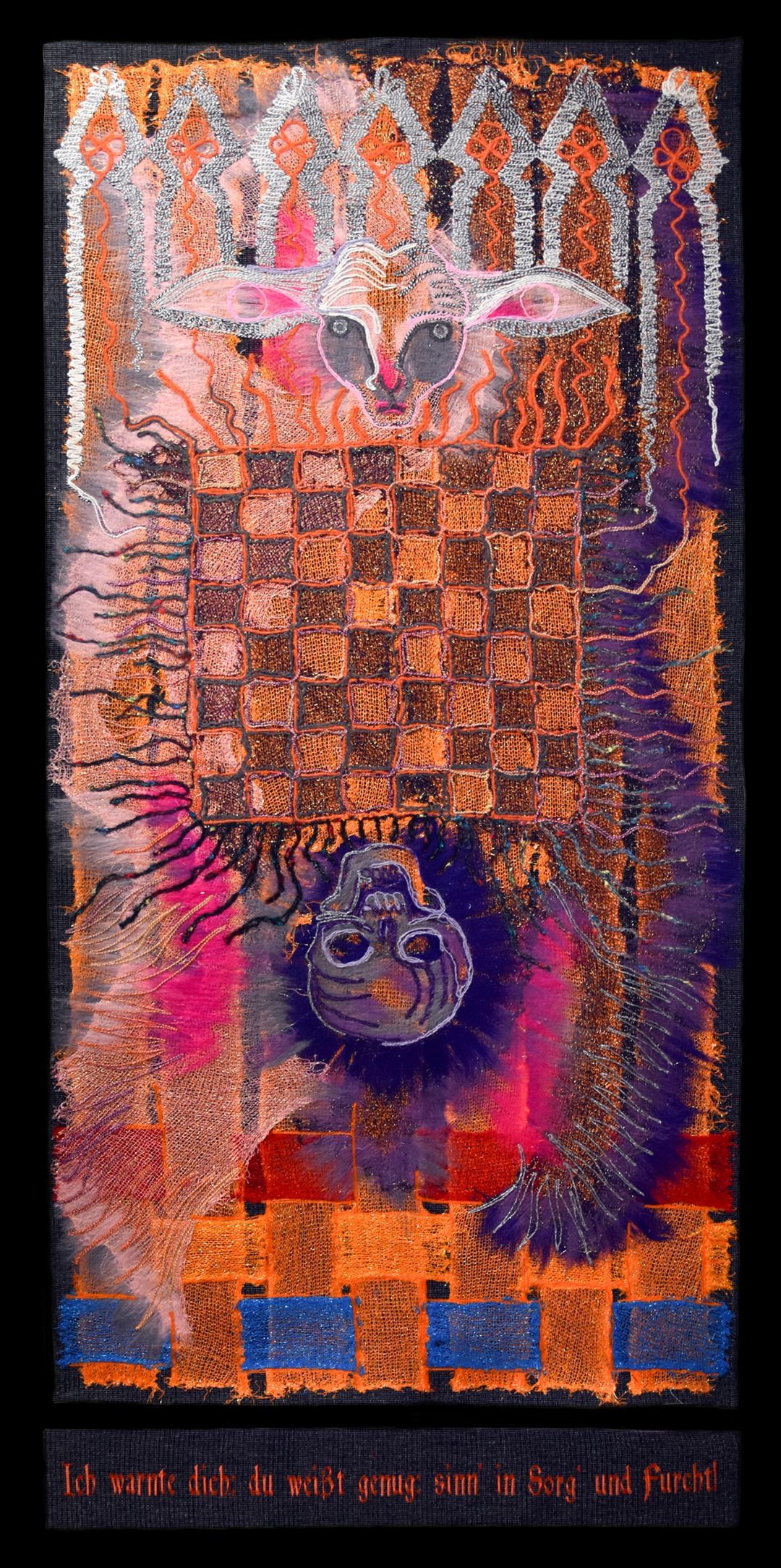
DAS LIED VON DER ERDE
Tierracide
Set against the vibrant orange knitted backdrop of the seventh tapestry, the Lamb is locked in a solemn game of chess with Death. The scene is rendered in festive yarns, shades of purple, grey and pink. LIke in Bergman's iconic film, the breaking of the seventh seal signals an unstoppable dance of death and destruction. Yet, within this fated moment, the arabesques shift and realign, suggesting that the rapture may yet restore balance tot he earthly Valley of Poverty and Nothingness. Humanity's salvation hinges on winning this eternal, symbolic game.
Erda has dissolved back into the roots of eternity, her presence now an echo. Her final song reverberates:
“I warned you; you know enough; contemplate—in distress and dread!”
Tierracide, 2023
Needle-felted tapestry
250 x 120 cm
Knitted wool, yarn, roving on wool mix
Ich warnte dich; du weisst genug: sinn’ in Sorg’ und Furcht!
—Erda, Der Ring des Nibelungen, Richard Wagner
SOLO EXHIBITION





